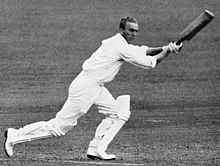Joe Hardstaff Jr
 Hardstaff in 1936 | ||||||||||||||||||||||||||||||||||||||||
| Personal information | ||||||||||||||||||||||||||||||||||||||||
|---|---|---|---|---|---|---|---|---|---|---|---|---|---|---|---|---|---|---|---|---|---|---|---|---|---|---|---|---|---|---|---|---|---|---|---|---|---|---|---|---|
| Full name | Joseph Hardstaff | |||||||||||||||||||||||||||||||||||||||
| Born | 3 July 1911 Nuncargate, Nottinghamshire, England | |||||||||||||||||||||||||||||||||||||||
| Died | 1 January 1990 (aged 78) Worksop, Nottinghamshire, England | |||||||||||||||||||||||||||||||||||||||
| Batting | Right-handed | |||||||||||||||||||||||||||||||||||||||
| Bowling | Right-arm medium | |||||||||||||||||||||||||||||||||||||||
| Relations |
| |||||||||||||||||||||||||||||||||||||||
| International information | ||||||||||||||||||||||||||||||||||||||||
| National side | ||||||||||||||||||||||||||||||||||||||||
| Test debut | 13 July 1935 v South Africa | |||||||||||||||||||||||||||||||||||||||
| Last Test | 10 June 1948 v Australia | |||||||||||||||||||||||||||||||||||||||
| Career statistics | ||||||||||||||||||||||||||||||||||||||||
| ||||||||||||||||||||||||||||||||||||||||
Source: ESPNcricinfo, 5 August 2020 | ||||||||||||||||||||||||||||||||||||||||
Joseph Hardstaff Jr (3 July 1911 – 1 January 1990)[1] was an English cricketer, who played in twenty three Test matches for England from 1935 to 1948. Hardstaff's father, Joe senior played for Nottinghamshire and England and his son, also named Joe, played first-class cricket as well.[2]
Cricket correspondent, Colin Bateman, remarked, "Hardstaff was one of the most artistic batsmen ever to set foot on a cricket field but he paid the high price of falling out with Gubby Allen".[1]
Life and career
Hardstaff was born in Nuncargate, Kirkby-in-Ashfield, Nottinghamshire.
One of the most elegant
The war robbed him, like so many others, of perhaps his best cricketing years, and his Test appearances were sporadic when cricket resumed, despite a brilliant unbeaten double century against
In 1947–48 Hardstaff
He remained a colossus on the county circuit, stroking 2,396 runs at 64.75 in 1947, but retired with just twenty three tests to his name, having scored 1,636 at an average of 46.74. He headed the national averages in 1949 with 2,251 runs at 72.61. The press clamoured for his reinstatement in the national side, but Allen's influence held sway.[1] On Hardstaff's retirement in 1955, he had almost 32,000 runs under his belt at 44.35, one of the highest scoring Nottinghamshire batsman in history, with a century against every county except his own. He recorded eighty three centuries, with ten double hundreds, and passed a thousand runs in a season thirteen times. In addition to three MCC tours to Australia, and one to the West Indies, he also played two seasons of first-class cricket in New Zealand after the war. He was also a fine, athletic outfielder, and took 36 wickets with his eccentric medium pace. (The highest scoring Nottinghamshire batsman was George Gunn who scored 35,208 runs.)
Hardstaff died in Worksop, Nottinghamshire, on the first day of 1990, aged 78.[1]
References
- ^ ISBN 1-869833-21-X.
- ^ "Hadlee's nine-for". ESPNcricinfo. Retrieved 13 November 2019.
External links
 Media related to Joe Hardstaff Jr at Wikimedia Commons
Media related to Joe Hardstaff Jr at Wikimedia Commons
